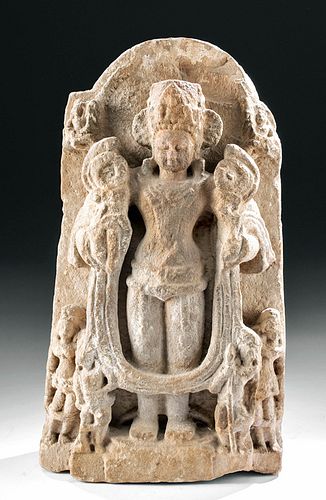8th C. Indian Stone Relief - Surya / Sun God
Lot 47c
About Seller
Artemis Fine Arts
686 S Taylor Ave, Ste 106
Louisville, CO 80027
United States
Selling antiquities, ancient and ethnographic art online since 1993, Artemis Gallery specializes in Classical Antiquities (Egyptian, Greek, Roman, Near Eastern), Asian, Pre-Columbian, African / Tribal / Oceanographic art. Our extensive inventory includes pottery, stone, metal, wood, glass and textil...Read more
Categories
Estimate:
$3,000 - $4,500
Absentee vs Live bid
Two ways to bid:
- Leave a max absentee bid and the platform will bid on your behalf up to your maximum bid during the live auction.
- Bid live during the auction and your bids will be submitted real-time to the auctioneer.
Bid Increments
| Price | Bid Increment |
|---|---|
| $0 | $25 |
| $300 | $50 |
| $1,000 | $100 |
| $2,000 | $250 |
| $5,000 | $500 |
| $10,000 | $1,000 |
| $20,000 | $2,500 |
| $50,000 | $5,000 |
| $100,000 | $10,000 |
| $200,000 | $20,000 |
About Auction
By Artemis Fine Arts
Oct 22, 2020
Set Reminder
2020-10-22 10:00:00
2020-10-22 10:00:00
America/New_York
Bidsquare
Bidsquare : Ancient & Ethnographic Art Through The Ages
https://www.bidsquare.com/auctions/artemis-gallery/ancient-ethnographic-art-through-the-ages-5850
Ancient art from Egypt, Greece, Italy and the Near East, as well as Asian, Fossils, Pre-Columbian, Native American, African / Tribal / Oceanic, Fine art, and much more! All categories, all price ranges... all legally acquired and guaranteed to be as described or your money back. Artemis Fine Arts info@artemisgallery.com
Ancient art from Egypt, Greece, Italy and the Near East, as well as Asian, Fossils, Pre-Columbian, Native American, African / Tribal / Oceanic, Fine art, and much more! All categories, all price ranges... all legally acquired and guaranteed to be as described or your money back. Artemis Fine Arts info@artemisgallery.com
- Lot Description
Central Asia, India, ca. 8th to 12th century. This stone stele depicts the Hindu deity Surya, the Sun God thought to perpetuate time by riding across the skies, holding open lotus blossoms in each hand; lotus flowers are associated with this solar deity, because they bloom in sunlight. Surya is flanked by his two wives, Rajni and Nisprabha, as well as his trusted attendants, Pingala (with an inkpot) and Dandin (with a sword). Surya is adorned by an elaborate crown and breastplate - the breastplate as he is traditionally depicted as a Central Asian warrior. Size: 7.5" W x 13" H (19 cm x 33 cm)
Temples in Pala were built of brick, with carved stone images like this one set into wall niches. The Pala Empire was the last major Buddhist power in India, although their sculptural art, as here, often includes Hindu elements and iconography. They are well known for their sculpture, which was influenced by the Gupta period, and in turn influenced artwork in Tibet, Nepal, and Southeast Asia.
See another stele with Surya at the Getty Museum (object name: BE087641) and the Philadelphia Museum of Art (accession number 1927-9-1).
Provenance: private J.H. collection, Beaverton, Oregon, USA, acquired around 2004; ex-antique store collection, Portland, Oregon, USA
All items legal to buy/sell under U.S. Statute covering cultural patrimony Code 2600, CHAPTER 14, and are guaranteed to be as described or your money back.
A Certificate of Authenticity will accompany all winning bids.
We ship worldwide and handle all shipping in-house for your convenience.
#150043Expected surface wear with losses to peripheries and high-pointed areas as shown. Deposits grace the surface.Condition
- Shipping Info
-
All shipping is handled in-house for your convenience. Your invoice from Artemis Gallery will include shipping calculation instructions. If in doubt, please inquire BEFORE bidding for estimated shipping costs for individual items.
-
- Buyer's Premium



 EUR
EUR CAD
CAD AUD
AUD GBP
GBP MXN
MXN HKD
HKD CNY
CNY MYR
MYR SEK
SEK SGD
SGD CHF
CHF THB
THB















